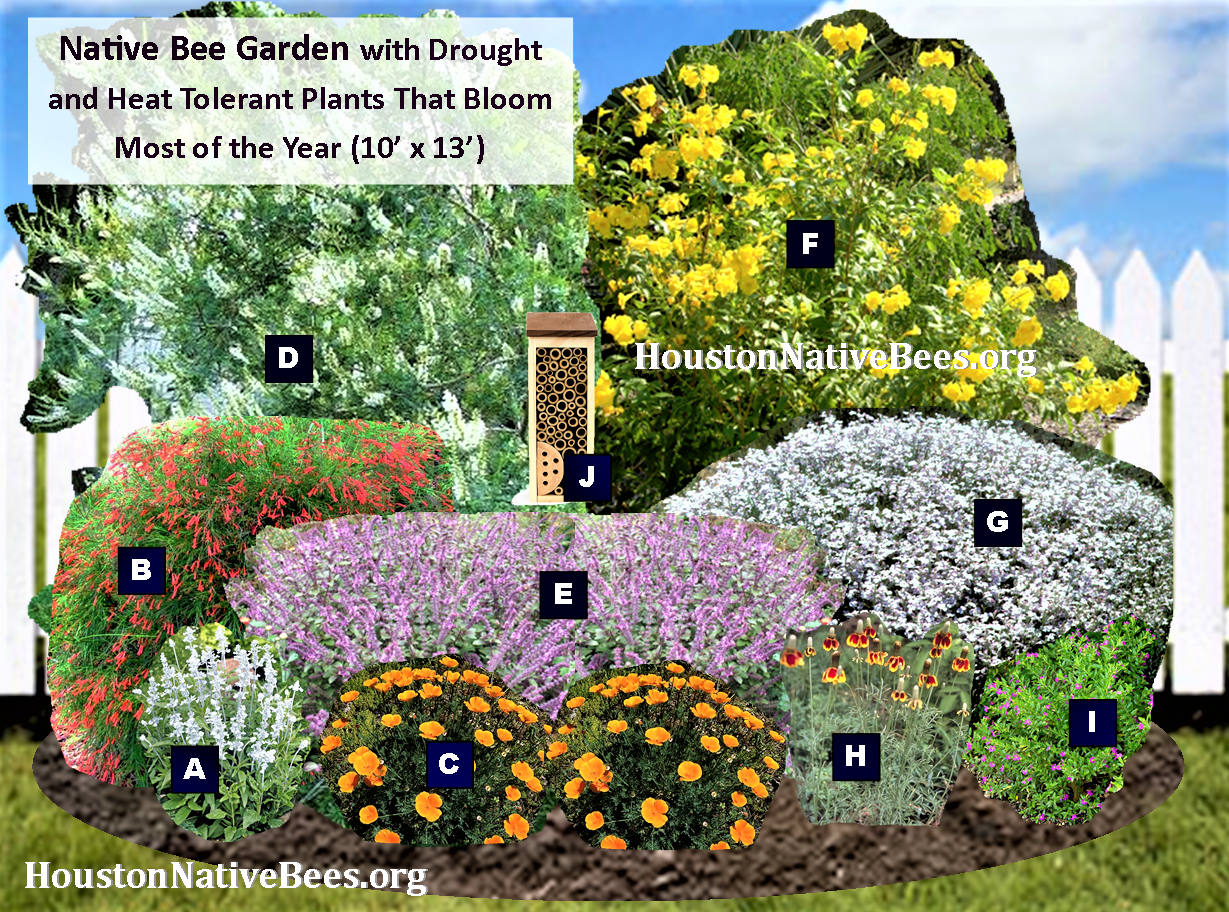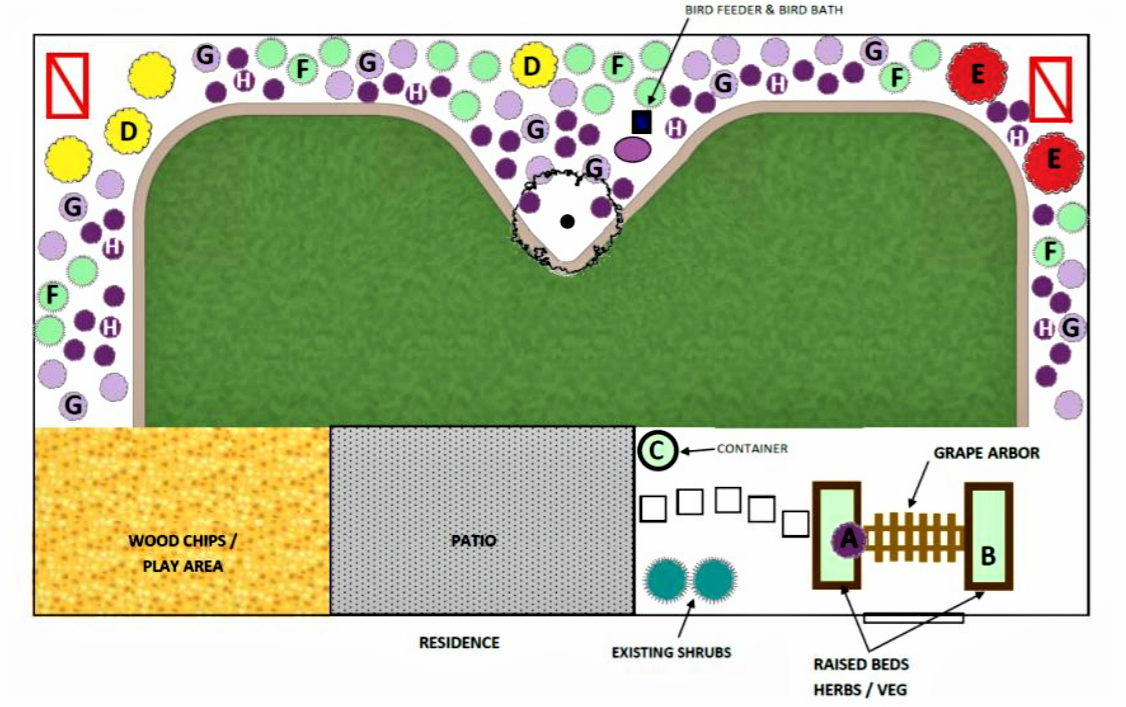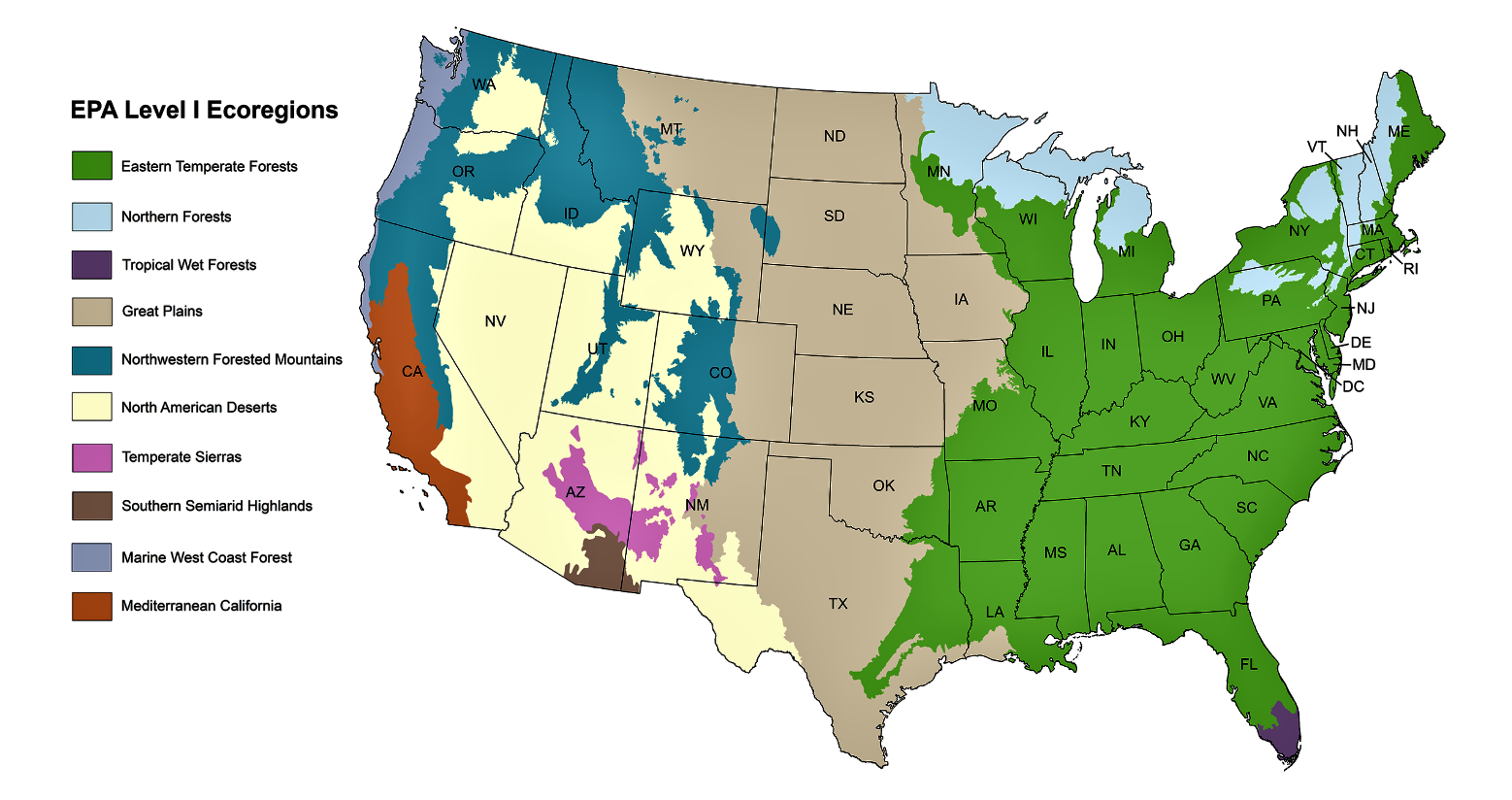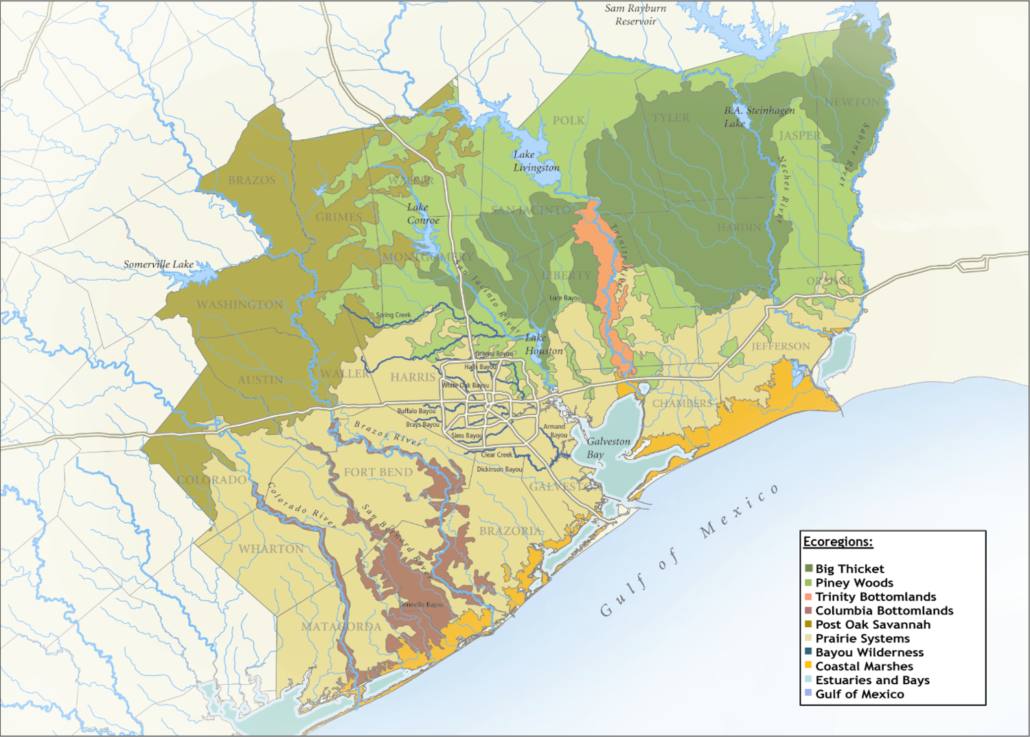Easy garden designs that also help native pollinators
Garden designs do not need to be complicated, expensive or time-consuming. Pollinators have simple needs: a year-round supply of pesticide-free food and water, and bare ground or wood for nesting. For questions about which plants are best, see my Top Native Plant and Tree Lists.
“We have to practice conservation on our private properties and balconies, not just in parks and preserves. In the past, conservationists worked exclusively where there weren’t a lot of people. Now, we need to find ways to thrive in human-dominated landscapes.” Doug Tallamy
Garden designs and plant lists, ready to print and take to the nursery!
Tips for Pollinator Garden Design
Print Version
Top Native Plant & Tree Lists
Print Version
Sample design for plant garden
This simple garden 10 ft X 13 ft design includes drought and heat tolerant plants that bloom and provide food most of the year, and are usually available locally.
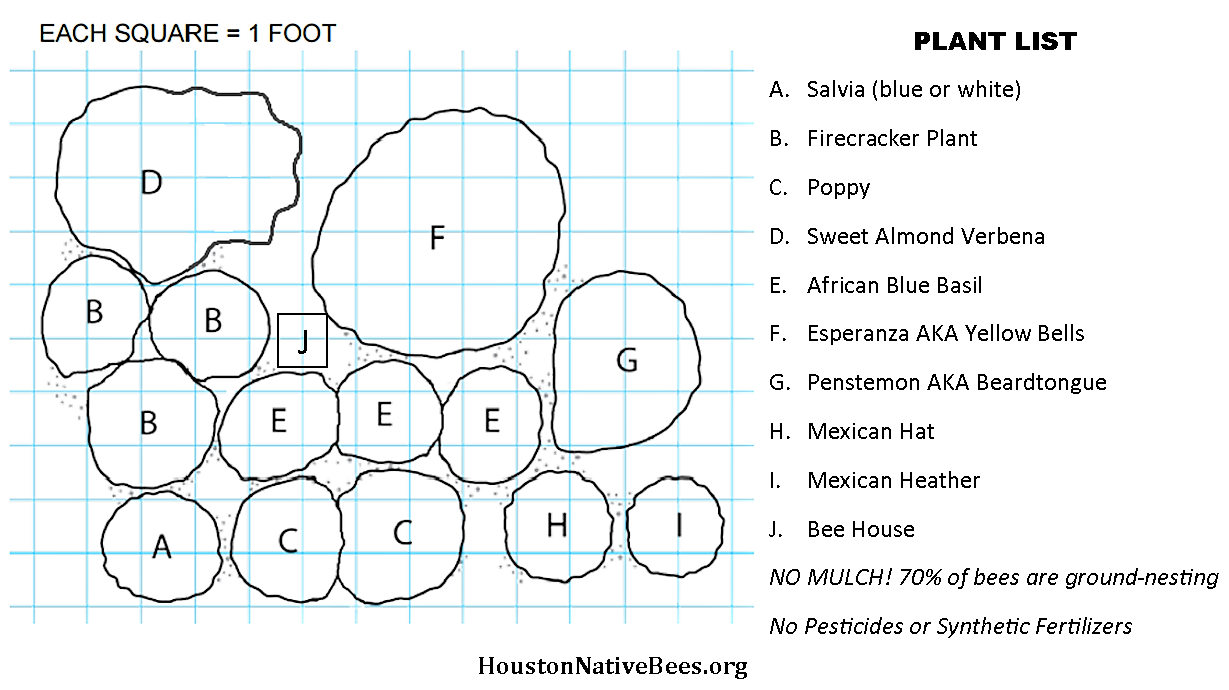
Prepare garden area
• Mix in a balanced organic fertilizer (I like Down to Earth brand)
Prepare plant holes
Add WITH plant, roughly:
- 50% potting mix such as Nature’s Yield (low cost) or Happy Frog (high cost)
- 25% compost/mulch (any organic brand)
- 25% coconut coir (place block in bucket of water, will expand generously)
- Handful of “plant food” (fertilizer), I prefer MicroLife Fertilizer (Houston company!), or you can find Happy Frog (high cost), or another organic fertilizer (low cost), but use one containing mycorrhizae (beneficial microbes)
- Handful of Earthworm Castings
- Generous pinch of rock phosphate, buy the bulk bucket not the brand names. A large container of rock phosphate is relatively inexpensive and will last practically forever. Phosphate aids root growth and establishment of new plants – it’s my favorite secret weapon in the garden!
Calculate food garden size
Calculations for vegetable garden size are available from many resources. Example of size recommendation for 4 people:
- 4,000 sqft of growing space/person.
- If 60% of your garden is grain/carbon crops, then 40% is veggies (4,000 x .40 = 1,600 sqft/person).
- Rows 4 ft x 25 ft provides 16 rows/person (4 x 25 = 100 sqft, 100 x 16 = 1,600 sqft).
- 1,600 sqft x 4 (people) = 6400 sqft or 64 rows (4 ft x 25 ft), about 14.5% of an acre (43,560 sqft).
Without pathways, the total area is approx. 256 ft x 25 ft. Hope that math is right!
Sample garden design for large lawn
I created this design for a friend whose yard was a blank slate. All plants are adapted for Houston’s hot, humid climate and drought-like conditions.
We emphasized use of native plants which are well-adapted to local soil and climate conditions (hybrids do not provide genetic diversity).
Install a diversity of flowering plants with diverse bloom-times, color, shapes and sizes, and group a minimum of 5-7 same-species plants together. I recommend sprinkling annual wildflower seed in between perennial plants to create a diversity of flower sizes and shapes. While these plants are available at most Houston nurseries, please only purchase plants from nurseries that are certified pesticide-free!
See the key to the recommended plants and trees in the design image below.
Key for lawn garden image
A. Mexican Flame Vine – butterflies
B. Herbs & Vegetables (esp. dill and fennel, ladybugs are attracted to it, host plant for swallowtail butterflies)
C. Container Flowers (eg. Ornamental Cabbage, cascading Petunias, sweet Alyssum, thyme)
D. 4-5’ flowering shrub, for example:
- Rosemary – bees, butterflies
- Firecracker Shrub – hummingbirds
- Senna Corymbosa – “Yellow Senna” – host for Sulfur butterflies
- Candletree, Cassia alata – bees
E. 5-8’ flowering shrub, for example:
- Vitex – “Chaste Tree” – bees
- Esperanza, AKA “Yellow bells” – bees
- Buttonbush – bees
- Coral bean – hummingbirds
F. Showstoppers, for example:
- Muhly grass – bird nesting material
- African Blue Basil – bees, butterflies
- Butterfly Bush – butterflies
- Yarrow – bees, ladybugs
G. 2-3’ Flowering Plants (Buy & plant these in groups of 3)
- Bee Balm – “Monarda” – bees
- Golden Baby Goldenrod, or Fireworks Goldenrod, or other Solidago species (Not allergenic contrary to popular belief) – buy packet of seeds and sprinkle near back of bed close to fence
- Zinnia & sunflowers – buy packets of seeds and sprinkle in back of bed near fence
- Coneflower, Echinacea – butterflies
- Butterfly Weed, Asclepias tuberosa – butterflies
- Red Valerian (Jupiter’s Beard), Ceranthus – hummingbirds
- Gregg’s Blue Mist Flower, Eupatorium greggii – bees
- Rudbeckia, “Black-eyed Susan” – butterflies
- Red Turks Cap – hummingbirds
H. 12-18” Flowering plants (Buy & plant these in groups of 3 or 5)
- Sage, Salvia species – hummingbirds, bees, butterflies
- Liatris, Liatris spicata – butterflies
- Red Birds in a Tree, Scrophularia macrantha – hummingbirds
- Penstemon, Penstemon species – bees
- Gomphrena, “Globe Amaranth” – bees
- Pincushion Flowers, Scabiosa – bees
- Lantana – butterflies, bees, hummingbirds
- Yarrow, Achillea species, bees, ladybugs
- Shrimp Plant, bees
- Poppy – buy seeds and sprinkle generously throughout bed, bees
Small Flowering Trees (that pollinators love)
- Mexican Buckeye
- Redbud
- Silver Bell, Halesia diptera
- Texas Olive, Cordia boissieri
More considerations for your garden
Garden lighting for pollinator health
Human health is affected by light, especially at night. Like humans, insects need natural light/dark cycles for health. Limit artificial light sources, even half a dark night is better than none. Smart low-glare outdoor lighting benefits human and animals. The solution to light pollution is 90% education and awareness, and 10% hardware.
And FYI, termites swarm at night under certain conditions and they’re attracted to artificial light sources around the home, such as porch lamps, motion lights, and light reflected from inside.
If artificial lighting is needed for human safety or security:
- retain some dark areas; turn lights off when not in use, or use motion sensors or timers
- mount fixtures low to ground; angle light downward below a 90-degree plane, and shield or hood light so not directly visible
Wavelength matters. To help pollinators, consider the wavelength of your lighting:
- use long-wavelength light greater than 560 nanometers (yellow, orange, red ~570-750nm)
- may use dim white solar powered light, avoid colored solar light
- avoid short-wavelength light (violet, blue, green ~400-510nm; white ~390-750nm); white LED light (5mW wavelength range ~275-950nm)
- avoid light filters, gels, or lenses; multi-colored lights; broad-spectrum
- minimize blue light emissions; bees are attracted to dangerous blue fluorescence in 430-480nm range
More lighting information:
- International Dark Sky Association
- SoftLight Houston
- Firefly Conservation & Research
- McDonald Observatory Dark Skies Initiative
- Participate in the annual Houston Audubon Society’s Lights Out campaign during spring and fall migration.
Pollinator-friendly landscape practices
These practices are safer for you, your family and pets, and the Earth. One of the largest threats to bees is a lack of safe habitat. Most native bees are solitary creatures, 70% of solitary bees live underground, while 30% live in holes inside of trees or hollow stems (only non-native honey bees live in hives).
- Go chemical-free for bees and humans. Avoid toxic synthetic pesticides, fertilizers, herbicides, and neonicotinoids. Use organic alternatives and natural solutions like adding beneficial insects like ladybugs and praying mantises to help keep pests away. More information on organic alternatives.
- Limit pruning. Bees make homes in dead or dying branches with hollow stems, if possible leave some dead trees and trunk stumps.
- Till soil with care to avoid killing ground nesting bees.
- Limit mowing grassy areas with low, dense cover.
- Avoid wood bark mulch. Bees can’t build a nest if mulch covers the ground. Consider compost instead, it provides similar weed suppression and water retention properties, yet allows for nesting and improves your soil.
- Provide nesting sites. Unmanicured landscapes create habitats and protect ground nesting sites under leaf litter, brush, rocks, etc. Leave an untouched plot of land for them in your garden; make or purchase a “bee condo” with small tube “apartments” for bee residents.
- Provide a safe haven. Keep area free of trash and animal waste that can attract insects harmful to pollinators.
- Provide trees for bees. Bees get most of their nectar from trees, which provide hundreds or thousands of blossoms for food, leaves and resin for nesting material, and natural wood cavities for shelter.
- Create a bee bath. Bees work up quite a thirst foraging and collecting nectar. Fill a shallow bird bath or bowl with clean water, and arrange pebbles, stones, or float wood to break the water’s surface where bees can land.
Create a bee hotel
If you install a “bee hotel” in your garden, it will soon be filled with busy leafcutter females building nests. Bee blocks are a great way to create nesting homes for leafcutter bees. Make sure holes are drilled 6 inches deep to encourage development of female bees. Mother leafcutters place female eggs deep and male eggs closer to the entrance. More info on bee walls, habitats and nesting blocks.
Here are some examples of bad bee house designs, published by Erin Biba in Gizmodo, June 2019: https://www.houstonnativebees.org/wp-content/uploads/2024/07/Learning-Activities.Bad-Bee-House-Design.pdf
The U.S. Ecoregion map by Doug Tallamy is useful because plants do not distribute themselves according to political boundaries like state or county. Plants grow where they can, based on soil type, rainfall, temperature, altitude, and past geological events like glaciation.


